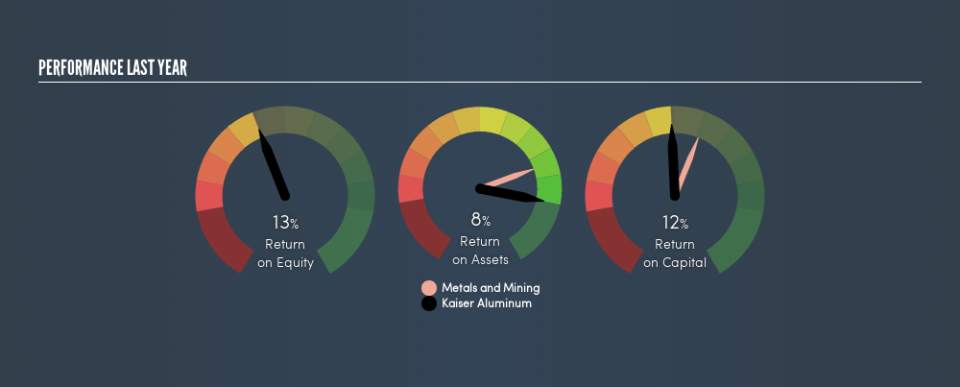A Close Look At Kaiser Aluminum Corporation’s (NASDAQ:KALU) 12% ROCE

Want to participate in a short research study? Help shape the future of investing tools and you could win a $250 gift card!
Today we are going to look at Kaiser Aluminum Corporation (NASDAQ:KALU) to see whether it might be an attractive investment prospect. In particular, we'll consider its Return On Capital Employed (ROCE), as that can give us insight into how profitably the company is able to employ capital in its business.
First of all, we'll work out how to calculate ROCE. Then we'll compare its ROCE to similar companies. Finally, we'll look at how its current liabilities affect its ROCE.
What is Return On Capital Employed (ROCE)?
ROCE is a measure of a company's yearly pre-tax profit (its return), relative to the capital employed in the business. In general, businesses with a higher ROCE are usually better quality. Overall, it is a valuable metric that has its flaws. Renowned investment researcher Michael Mauboussin has suggested that a high ROCE can indicate that 'one dollar invested in the company generates value of more than one dollar'.
How Do You Calculate Return On Capital Employed?
Analysts use this formula to calculate return on capital employed:
Return on Capital Employed = Earnings Before Interest and Tax (EBIT) ÷ (Total Assets - Current Liabilities)
Or for Kaiser Aluminum:
0.12 = US$145m ÷ (US$1.4b - US$204m) (Based on the trailing twelve months to March 2019.)
So, Kaiser Aluminum has an ROCE of 12%.
See our latest analysis for Kaiser Aluminum
Does Kaiser Aluminum Have A Good ROCE?
ROCE can be useful when making comparisons, such as between similar companies. In our analysis, Kaiser Aluminum's ROCE is meaningfully higher than the 8.8% average in the Metals and Mining industry. We would consider this a positive, as it suggests it is using capital more effectively than other similar companies. Independently of how Kaiser Aluminum compares to its industry, its ROCE in absolute terms appears decent, and the company may be worthy of closer investigation.
When considering this metric, keep in mind that it is backwards looking, and not necessarily predictive. ROCE can be misleading for companies in cyclical industries, with returns looking impressive during the boom times, but very weak during the busts. ROCE is only a point-in-time measure. We note Kaiser Aluminum could be considered a cyclical business. Future performance is what matters, and you can see analyst predictions in our free report on analyst forecasts for the company.
How Kaiser Aluminum's Current Liabilities Impact Its ROCE
Short term (or current) liabilities, are things like supplier invoices, overdrafts, or tax bills that need to be paid within 12 months. Due to the way ROCE is calculated, a high level of current liabilities makes a company look as though it has less capital employed, and thus can (sometimes unfairly) boost the ROCE. To counter this, investors can check if a company has high current liabilities relative to total assets.
Kaiser Aluminum has total liabilities of US$204m and total assets of US$1.4b. As a result, its current liabilities are equal to approximately 14% of its total assets. Current liabilities are minimal, limiting the impact on ROCE.
What We Can Learn From Kaiser Aluminum's ROCE
With that in mind, Kaiser Aluminum's ROCE appears pretty good. Kaiser Aluminum looks strong on this analysis, but there are plenty of other companies that could be a good opportunity . Here is a free list of companies growing earnings rapidly.
If you like to buy stocks alongside management, then you might just love this free list of companies. (Hint: insiders have been buying them).
We aim to bring you long-term focused research analysis driven by fundamental data. Note that our analysis may not factor in the latest price-sensitive company announcements or qualitative material.
If you spot an error that warrants correction, please contact the editor at editorial-team@simplywallst.com. This article by Simply Wall St is general in nature. It does not constitute a recommendation to buy or sell any stock, and does not take account of your objectives, or your financial situation. Simply Wall St has no position in the stocks mentioned. Thank you for reading.

